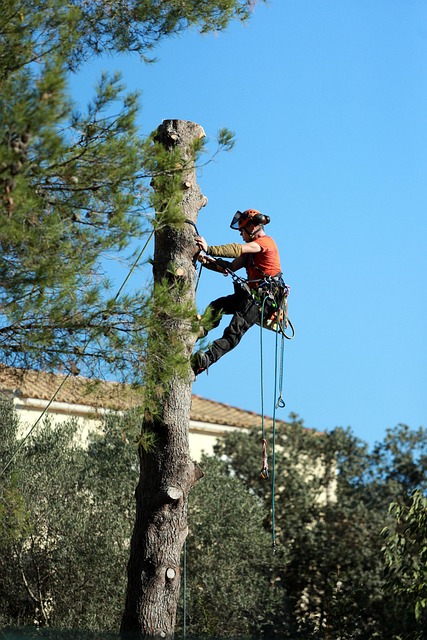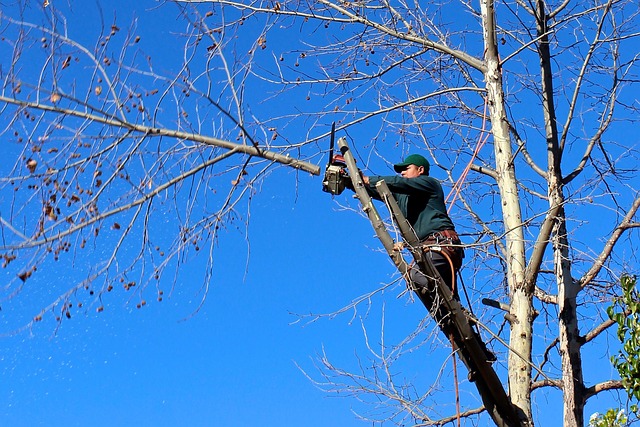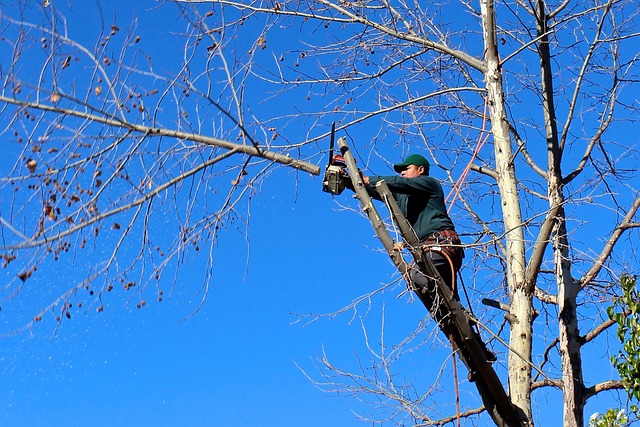Tree removal in Palmer is crucial for property safety, addressing diseased or hazardous trees that pose risks to infrastructure and surroundings. Professional arborist services are essential for precise tree trimming and safe removal, adhering to industry standards and regulations. The structured process involves health assessment, safety inspections, meticulous cutting, branch removal, trunk disposal/recycling, and thorough cleanup. Responsible practices include proper disposal and recycling initiatives to maintain Palmer's green spaces and promote ecological balance while enhancing landscape well-being through balanced tree care.
In Palmer, proper tree management is essential for both aesthetic appeal and safety. This article delves into the intricacies of tree removal, exploring when and why it’s necessary. We’ll guide you through the safety considerations for trimming and removal processes, offering a step-by-step insight into the process unique to Palmer. Additionally, we discuss responsible tree disposal methods, emphasizing environmental impact and sustainable practices. Discover how to navigate tree management effectively with expert advice tailored to Palmer.
- Understanding Tree Removal: When and Why It's Necessary
- Safety Considerations for Tree Trimming and Removal
- The Process of Tree Removal in Palmer: Step-by-Step Guide
- Responsible Tree Management: Disposal and Environmental Impact
Understanding Tree Removal: When and Why It's Necessary

In many cases, tree removal in Palmer isn’t just about aesthetics; it’s a necessary practice for maintaining safety and the health of your property. Trees that are diseased, damaged, or poorly placed can pose significant risks, from falling branches to blocking essential infrastructure like power lines. Recognizing when a tree needs to be removed is crucial for preventing potential hazards and ensuring the longevity of other plants on your property.
Regular tree trimming and removal services play a vital role in creating a balanced and harmonious environment. Professional arborists can assess whether a tree is salvageable or if its roots, trunk, or branches require careful cutting back. This proactive approach to tree care not only enhances curb appeal but also promotes the overall well-being of your landscape, making it an essential aspect of property maintenance for Palmer residents.
Safety Considerations for Tree Trimming and Removal

When it comes to tree trimming and removal in Palmer, safety should always be the top priority. Before embarking on any task involving trees, whether it’s a simple trim or complete removal, consider the potential hazards associated with heights and heavy equipment. Professional tree service providers in Palmer are trained to navigate these challenges safely, ensuring that all work is conducted according to industry standards and local regulations. This includes using proper safety gear, such as hard hats, harnesses, and safety lines, especially when working at elevated heights.
Additionally, the type of equipment used plays a crucial role in safety. Trees, particularly large ones, can present complex challenges during removal. Professional services invest in state-of-the-art equipment designed for precision and safety. From chain saws to specialized lifting gear, these tools help minimize risks, ensuring that the process is efficient while keeping everyone involved out of harm’s way. Remember, when it comes to tree removal Palmer residents should always opt for licensed and insured professionals who prioritize safety above all else.
The Process of Tree Removal in Palmer: Step-by-Step Guide

When it comes to tree removal in Palmer, understanding the process is crucial for a safe and efficient outcome. Here’s a step-by-step guide that highlights the key aspects of tree removal services in your area.
First, professionals will assess the tree to determine the best method for removal. This involves evaluating factors like the tree’s health, its proximity to structures and power lines, and the potential impact on surrounding vegetation. Once the plan is approved, the process begins with a thorough inspection to ensure safety. Next, equipment such as chainsaws and wood chippers are utilized to carefully cut down the tree. After the tree is brought down, branches are removed, and the trunk is either chipped or cut into manageable pieces for disposal or recycling. Finally, the area is thoroughly cleaned, ensuring no debris remains behind.
Responsible Tree Management: Disposal and Environmental Impact

Responsible tree management, including proper disposal and environmental consideration, is an essential aspect often overlooked during tree removal processes, especially in areas like Palmer where urban landscapes coexist with natural habitats. When a tree needs to be removed, it’s crucial to follow sustainable practices to minimize ecological disruptions. This involves properly disposing of the felled tree and its limbs to prevent habitat destruction for local wildlife and reduce potential soil erosion.
In Palmer, tree removal services should adhere to environmental regulations and promote recycling initiatives. For instance, wood chips derived from trimmed branches can be used as mulch in local parks or residential gardens, fostering a circular economy. Responsible management also includes planting new trees to replace those removed, ensuring the long-term health of the city’s green spaces. By prioritizing these practices, Palmer can maintain a balanced ecosystem while providing safe and aesthetically pleasing public areas for its residents.
Tree removal in Palmer is a necessary practice for maintaining a safe, healthy, and aesthetically pleasing urban environment. Understanding when and why tree trimming or complete removal is required, along with adhering to safety guidelines, ensures that these processes are carried out efficiently and responsibly. By following the step-by-step guide and considering the environmental impact, Palmer residents can effectively manage their trees while minimizing disruptions. For any Tree Removal Palmer needs, it’s crucial to engage professionals who prioritize both safety and sustainable practices.
